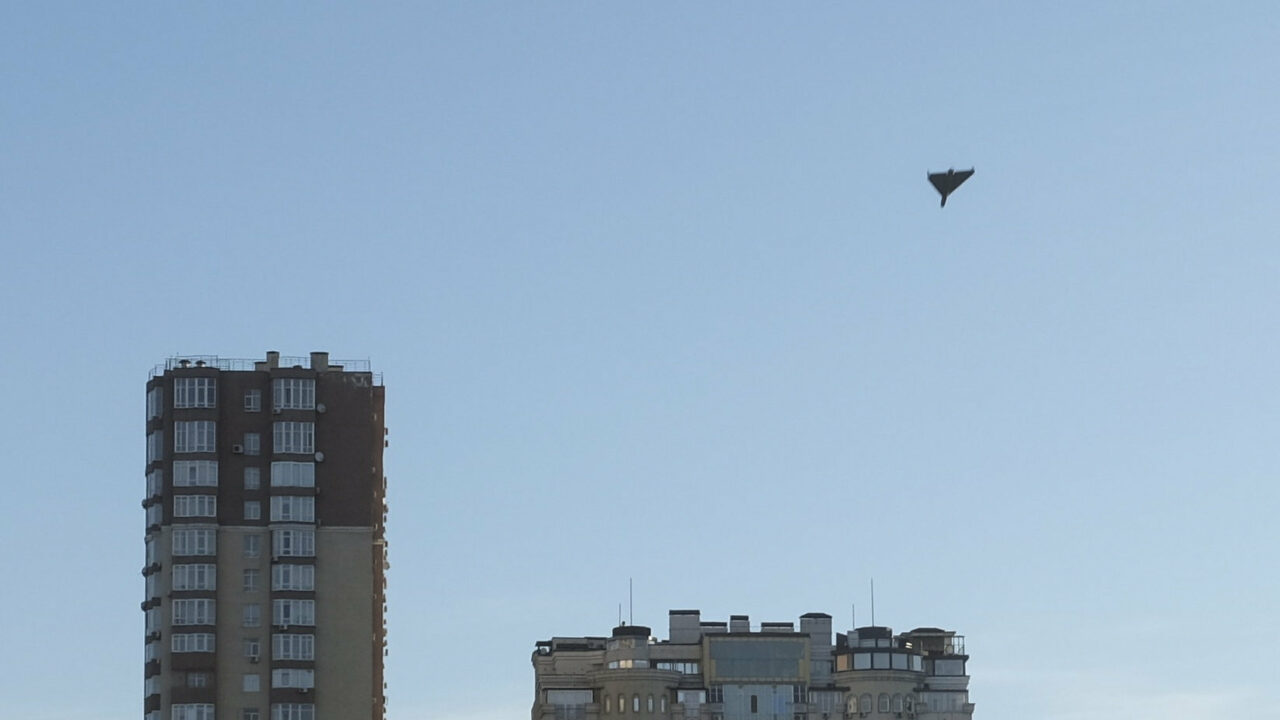No loitering: What Russia’s Iranian drones could mean for Ukraine
Russia is using Iranian-made drones to make up for its other shortcomings. Their use is unlikely to prove a game-changer – but Europeans should still assist Ukraine to defend against them
Russia has begun raining Iranian-made drones and loitering munitions down on Ukraine, using them to attack both infrastructure and civilians. So far, the operational impact of these drones appears to be limited. However, if Russia deploys them in greater numbers, begins to use them in combination with other systems or in swarms, or better integrates them within its military operations, they could still pose a significant threat to Ukrainian forces, civilians, and infrastructure.
Russia has undergone a remarkable demotion from being one of Iran’s main arms suppliers to now relying on Iranian unmanned aerial vehicles (UAV, or drones) and loitering munitions. Their use confirms that Russia’s own unmanned aircraft programme is not up to the task; nor is its air force, which has failed to destroy Ukraine’s air defences or achieve control of its air space, while providing poor-quality support to ground troops.
Russian forces are using at least three different Iranian-made systems – two of which this author previously identified as likely candidates for sale to Moscow: the Mohajer-6, a tactical combat UAV with a 200km range that is capable of launching small precision-guided munitions and anti-tank missiles; and the Shahed-136 loitering munitions (alongside its little brother, the Shahed-131). The Mohajer and Shahed platforms differ substantially from one another in capabilities and purpose. The former is more versatile and used for intelligence, surveillance, and reconnaissance as well as strike operations; the latter is a small satellite-guided missile used only to directly attack targets.
Unmanned aerial vehicles, including the Mohajer-6
Moscow has been forced to look for off-the-shelf drone solutions from Iran because of the sporadic availability and negligible impact of its own combat UAVs, such as the Forpost-R – a licensed upgraded copy of the Israeli Searcher Mk. II – and the Orion (Inokhodets). Without these alternatives, the Russian forces lack drones that can provide decent target acquisition and persistent precision strike capabilities. The Russian military has only a limited number of systems and has integrated them poorly within its units, leading to limited results in finding, interdicting, and engaging enemy units. This immature concept of operations on how to integrate and effectively employ UAVs has led to poor results on the ground and highlights the full extent of Russia’s UAV operational failure. This is especially the case for scouting, identifying, and destroying targets, as well as situational awareness – according to statements and complaints from Russian soldiers. The military has recently made attempts to address this situation, for instance through a “Dronnitsa” (drone) quadcopter workshop in early September and UAV training sessions for conscripted troops. This suggests a change in Russian officers’ mindset, though it may well be too little, too late.
The Mohajer-6 is similar to the Turkish-made TB2 that Ukraine’s armed forces are using (though the TB2 can fly for longer than the Iranian model and at higher altitudes). The Mohajer can carry up to four Ghaem-series precision guided munitions, Almas anti-tank guided missiles, or unguided Hydra rockets, while its thermal sensors and laser rangefinder mean it can be deployed in both day and night operations. Russian forces likely intend to use this platform to identify and engage high-value targets such as long-range artillery systems, command-and-control nodes, and tactical assembly areas deeper behind Ukrainian lines. This is both the primary purpose of the Mohajer-6 and the type of UAV capability the Russians have lacked the most up to now.
Loitering munitions, including the Shaheds
Alongside the Mohajer-6, Russia is using the Shahed-131 and 136 loitering munitions (renamed Geran 1 and 2 by the Russians) to make up for both the disappointing performance of its air force and the dwindling availability of long-range munitions capable of precision strikes. Stocks of these missiles have depleted considerably since the start of the war, and they could now be more difficult to produce because of Western sanctions on key electronic components.
Russia is mainly using the Shahed loitering munitions to attack civilian targets and power infrastructure. Strikes on military objectives, including artillery and headquarters, have been the exception rather than the rule – which could cast doubt on the strategic significance of these weapons in the strict operational sense. Nevertheless, it would be a mistake to prematurely disregard their role, particularly given the psychological effect on the Ukrainian population and the possibility of deploying these systems in large, coordinated groups (or ‘swarms’).
Shaheds offer several advantages. They are both quickly deployable in swarms via truck-mounted containers and relatively cheap, with an approximate cost of $20,000 per unit. They also have a long range of around 1,500km and 900km for the 136 and 131 variants, respectively. Furthermore, their design and slow cruising speed mean they can easily avoid radar detection. Their deployment in swarms could therefore saturate Ukrainian air defence systems and cause significant damage. The rumoured delivery by Iran of Arash-2 loitering munitions – which have a longer range and much heavier warhead – could permit Russia to inflict greater damage, more deeply into Ukrainian territory.
The two Shahed systems are relatively small, slow-flying (180-200kmh) delta-wing missiles that rely primarily on a global navigation (GNSS) or global positioning (GPS) satellite and inertial guidance systems to attack at specific geographic coordinates. They can also be fitted with an imaging infrared (IIR) or anti-radiation seeker for target identification and suppression of air defences. This means that they are effective only against preselected stationary targets (unlike “kamikaze” drones, which can select their own static or moving targets).
As a solution, Russian military commentators have proposed their use in tandem with ‘spotting drones’ such as the Mohajer-6, as part of a single interface dubbed by these commentators a “reconnaissance-strike complex”. When used in this way, the spotting drones find targets and quickly relay their coordinates to the Shahed or a centralised UAV command unit, reducing the delay between target identification and engagement. This would also improve the accuracy of these systems against moving targets such as HIMARS and mechanised columns, and increase their operational impact. For the time being, it is unlikely that Russia has the capacity to establish such a military ecosystem and deploy UAVs and loitering munitions together in this way.
The Shaheds also have limitations. Ukrainian engineers who disassembled a downed Shahed loitering munition have confirmed that their internal components, such as their processing units and GNSS guidance system, are mostly civilian-grade and are vulnerable to electronic warfare. If the satellite signal is jammed or spoofed, Shaheds can rely on the back-up inertial navigation system, though their accuracy significantly diminishes. Russia has installed more resilient GNSS satellite navigation modules to offer additional protection against electronic warfare, but this seems only partially effective, according to Ukrainian sources. The use of radar decoys by Ukrainian forces, moreover, could deceive the drones’ anti-radiation seekers, if they have them installed. And, last but not least, their slow speed and low altitude means they are vulnerable to shoulder-fired anti-aircraft missiles like the Stinger or anti-aircraft guns such as the German-made Gepard. Some Ukrainian soldiers have even suggested they could be downed by Soviet-era heavy machine guns.
How to help Ukraine defend against Russia’s Iranian drones
Both the potential and weaknesses of the Shaheds make the delivery to Ukraine of additional short- and medium-range air defence systems even more urgent. Missile defences such as the NASAMS and IRIS-T are best suited for protecting critical infrastructure and cities, but the West should consider sending self-propelled options, including the French-made Crotale and additional anti-aircraft autocannons like the Gepard. These would provide Ukrainian troops with effective point and manoeuvre defence capabilities against loitering munitions along Ukrainian frontlines.
Drones and loitering munitions alone cannot solve the structural problems affecting the Russian military
Drones and loitering munitions alone cannot solve the structural problems affecting the Russian military. Nevertheless, the proliferation and widespread use of loitering munitions should prompt Western partners to help Kyiv build a layered air-defence complex that integrates conventional missile defence systems with powerful electronic warfare capabilities. European decision-makers should also work to improve their own countermeasures against potential Russian attacks on military and civilian targets, while also developing and integrating this technology into their armed forces.
The European Council on Foreign Relations does not take collective positions. ECFR publications only represent the views of their individual authors.



